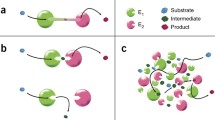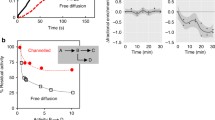Abstract
We propose a simple mechanism which enables decrease of the free pool of channelled metabolite in static spatial channelling, when the concentration of the enzyme consuming the channelled metabolite is greater than the concentration of the enzyme producing this metabolite. Spatial channelling occurs between two enzymes when the common metabolite is released to a small space between these enzymes and does not form a ternary covalent complex with them, as is the case in covalent (dynamic or static) channelling. The mechanism proposed is qualitatively independent of rate constants, metabolite concentrations as well as other kinetic properties and is quantitatively significant for all physiologically relevant conditions. Calculations show that the free metabolite pool must decrease, when the concentration of the enzyme consuming the channelled metabolite is greater than the enzyme producing it. This mechanism is much more effective than increase in the concentration (or rate constant) of the enzyme consuming the metabolite in the absence of spatial channelling.
Similar content being viewed by others
References
Srere PA: Complexes of sequential metabolic enzymes. Annul Rev Biochem 56: 89–124, 1987
Keleti T, Ovadi J, Batke J: Kinetic and physico-chemical analysis of enzyme complexes and their possible role in the control of metabolism. Prog Biophys Molec Biol 53: 105–152, 1989
Srere PA, Ovadi J: Enzyme-enzyme interactions and their metabolic role. FEBS Lett 268: 360–364, 1990
Ovadi J: Physiological significance of metabolic channelling. J Theoret Biol 152: 1–22, 1991
Stanley KK, Tubbs PK: The role of intermediates in mitochondrial fatty acid oxidation. Biochem J 150: 77–88, 1975
Bartlett K, Hovik R, Eaton S, Watmough NJ, Osmundsen H: Intermediates of peroxisomal β-oxidation. Biochem J 270: 175–180, 1990
Eaton S, Bhuiyan AKMJ, Singh Kler R, Turnbull TM, Bartlett K: Intramitochondrial control of the oxidation of hexadecanoate in skeletal muscle. Biochem J 289: 161–168, 1993
Westerhoff HV, Melandri BA, Venturoli B, Azzone GF, Kell DB: A minimal hypothesis for membrane-linked free-energy transduction. Biochim Biophys Acta 768: 257–292, 1984
Cornish-Bowden A: Failure of channelling to maintain low concentrations of metabolic intermediates. Eur J Biochem 195, 103–108, 1991
Mendes P, Kell DB, Westerhoff HV: Channelling can decrease pool size. Eur J Biochem 204: 257–266, 1992
Cornish-Bowden A, Cardenas ML: Channelling can affect concentrations of metabolic intermediates at constant flux: artefact or reality? Eur J Biochem 213: 87–92, 1993
Mendes P, Kell DB, Westerhoff HV: Why and when channelling can decrease pool size at constant net flux in a simple dynamic channel. Biochim Biophys Acta 1289: 175–186, 1996
Srivastava DK, Bernhard SA: Enzyme-enzyme interactions and the regulation of metabolic reaction pathways. Curr Top Cell Regul 28: 1–68, 1986
Easterby JS: Temporal analysis of the transition between steady-states. In: A Cornish-Bowden and ML Cardenas (eds). Control of Metabolic Processes. Plenum Press, New York, 1990, pp 281–290
Atkinson DE: Cellular energy metabolism and its regulation. Academic Press, New York, pp 13–30
Ovadi J: Channelling and channel efficiency – theory and analytical implications. In: A Cornish-Bowden and ML Cardenas (eds). Control of Metabolic Processes. Plenum Press, New York, 1990, pp 271–279
Hyde CC, Ahmed SA, Padlan EA, Miles EW, Davies DR: Three-dimensional structure of the tryptophan synthase α2β2 multienzyme complex from Salmonella typhimurium. J Biol Chem 263: 17857–17871, 1988
Author information
Authors and Affiliations
Rights and permissions
About this article
Cite this article
Korzeniewski, B., Quant, P.A. A simple mechanism decreasing free metabolite pool size in static spatial channelling. Mol Cell Biochem 169, 135–142 (1997). https://doi.org/10.1023/A:1006882029611
Issue Date:
DOI: https://doi.org/10.1023/A:1006882029611




